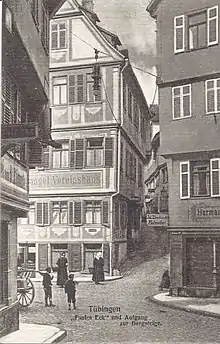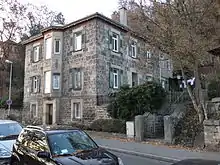Neckarhalde, Tübingen
The Neckarhalde is an 841-metre (0.5 mi) road in Tübingen,[1][2] Germany, on the southern slope below Hohentübingen Castle.
.jpg.webp)

Location
The Neckarhalde is an east–west road parallel to the Neckar river and Tübingen's city wall, starting in the old town of Tübingen. The Wienergässle links the road with the market place, where the town hall is located. Starting at the "Lazy Corner" above the Tübinger Stift, an old Protestant seminary, the road heads west down to the river and ends by meeting the Biesinger and Hirschauer roads. Apart from the more distant Mühlstraße (Mill Road), it is the only road leaving the old town to the south. Approximately halfway through the length of the road, it crosses a pedestrian and bicycle tunnel, which continues to the Avenue Bridge.
History
For many years, the buildings in Neckarhalde did not have a sewage system. Building number 7, in particular, became known for its hard-to-clean privy. As described in the "Caterpillar hymn" (Raupenhymne),[3] it was necessary as the winegrowers carried the smelly solids up the mountain to use it as fertilizer on strawberries and grapevines. All Tübingen wine growers are colloquially called "Caterpillars", even if they do not live in Lower Tübingen, while the expression "Gôgen" usually describes inhabitants of the lower city.[4]
Notable buildings

.jpg.webp)

The following is a list of house numbers and the notable buildings or persons associated with them.
- 1
- Former bakery of the former Augustinian Monastery, today it is the new Ephorat of the Protestant seminary, a protected two-and-a-half– to three-floor solid building on a hillside with a mansard roof, which was rebuilt in 1779 and 1780.[7]
- 2
- The Hospiz Hotel was closed on 17 December 2017 due to fire protection. The church-owned building may be sold instead of restored.[8] The traditional building previously was operated for over seventy years by the Veihelmann family. Whether or how it will be restored, is still unknown.[9]
- 6
- Across from the Protestant seminary is the former restaurant Seif. The operator of the restaurant, Ferdinand Forstbauer, was a former trained soap boiler. Later, until 1934 the location was another restaurant, Hecht, which became a brothel and closed for that reason.
- 8
- Rudolf Bultmann's student accommodation.[10]
- 10
- Former literary bookstore Quichotte (today located in "Bei der Fruchtschranne 10").[11]
- 11
- Cäsar Hirsch's student accommodation.
- 12
- Birthplace of Albert Knapp.[12]
- 14
- Greek restaurant and pension Traube.
- 19
- Before the war events of 1634 and 1635, astronomer Wilhelm Schickard worked here. It is thought that his wife and some of his children died during the black death. After supposedly fleeing the plague, he returned to Tübingen for fear of looting. He later succumbed to the epidemic and died.[13]
- 24
- Birthplace of poet Ludwig Uhland. In 1830 the Hirschauer Tor was demolished. It was located between Neckar and Hohentübingen Castle. It was one of the five city gates in the old city wall of Tübingen and opened the way to Hirschau and Rottenburg. From the gate the single-storey remains of the round tower, a former prison, called Diebsturm, still exists.[14]
- 26a
- Old town outpatient clinic of the Tübingen Academy for Behavioral Therapy gGmbH (TAVT), in which statutory health insurance companies can serve billable psychotherapeutic treatments.[15]
- 27
- Stiftskirchengemeinde, a common east-middle-west parish office. The Jewish professor Leopold Pfeiffer (born 25 October 1821 in Weikersheim, died 4 November 1881 in Tübingen) lived here at Hirschauer Tor. He specialized in civil litigation and criminal proceedings in connection with criminal law and from 1851 to 1881 was an associate professor at the University of Tübingen. He died in the Jewish sector. His body was buried at Pragfriedhof, Stuttgart.[16]
- 30b
.png.webp)
- Former Tübingen district court.[17]
- 31
- Theodor Haering House, museum villa and municipal collections. In January 1989, a fire broke out in the house and the collection was moved to former Kornhaus and a new museum at Kornhausstraße 10.[18] The Thouse continues to be used by the museum as a depot. As a child, Peter Weiss lived in this house and the museum garden.[19][20]
- 32
- Former Tübingen unemployed organisation and asylum center. The pupils' club Schüli was located in one of the three houses of the Protestant Church in this street.[21] A group of developers acquired the 1832-built, listed building to renovate it and then rent it as living space. Today the non-profit club Tübingen Vanishing Points is there, which supports refugees in their efforts to obtain a right to stay in Germany.[22]
- 36
- Catholic Children's House Sankt Johannes.[23]
- 37
- The "Neckarblick" house, a listed residential building built in 1892 by architect Franz Bärtle.[24]
- 38
- The home of Julie Bonhoeffer, mother of Karl Bonhoeffer and grandmother of Dietrich Bonhoeffer.[25]
.jpg.webp)
- 40
- "Pfälzerhaus" (Palatinate House), former restaurant "Zur Pfalz", and location of founding student fraternity "Palatia", today the Asylum Center Tübingen, Tübingen Unemployed Club (TAT) and the ecumenical pupils' club Schüli.
- 41
- Glassed Apartments,[26] built in 1968, were the home of literary scholar Hans Mayer, designed by architect Heinrich Johann Niemeyer.[27]
- 43
- The Herb House, built in 1959, was inspired by nature and designed by architect Heinrich Johann Niemeyer.
- 46
- A residential building built by Karl Haug in the late nineteenth century according to plans by Conradin Walther (1846–1910) from Nuremberg.[24]
- 47
- Built in 1904 as the villa of Professor Hermann Vierordt, it was bought by the Old Strasbourg fraternity Germania in 1952.

- 50
- Built in 1866 by Karl Haug, modified later.[24]
- 52
- Mathilde Weber House, built in 1870.
- 55
- Until the 2010s, the Deutsche Gesellschaft für Verhaltenstherapie was located here.[28]
- 56
- Villa Lust by district judge Ludwig Lust; in 1888 he transformed the fallow vineyards behind the villa into a small park called Ludwigslust,[29][30] "equipped with grotto, fountain basin and a luxurious cast-iron winter garden, which he had bought specially from an old Stuttgart villa"; it was the home of Konrad Knopp.[31]
- 64
- Edith-Stein-Karmel;[32] 1899-built, five-stack timbered house on the hill with a bay window in the Renaissance Revival style, inhabited by one of the Baron von Hügel family with his wife, born with the name Von Soden; local historian Eugen Nägele in his Tübinger Blätter praised "the unmistakable pure old German style" of the villa in contrast to other mixed-style buildings in "Tübingen Nice", planning by Conradin Walther. The "Villa Hügel" was transformed in 1978 into a Carmelite monastery for Cologne nuns including the famous nun Waltraud Herbstrith.[33]
- 70
- Cafe KaffeeKränzle.
Junctions
The Neckarhalde branches at its upper, northeastern end, the so-called Faules Eck (Lazy corner), into the Burgsteige, Wienergässle, Kronenstraße, Münzgasse and Klosterberg. The origin of this colloquial name is uncertain. It may come from the smell of damp wood or due to the Neckar timber rafting that was transported up the Neckarhalde and for a time was temporarily stored or by the fact that there the woodworking timber traders there scolded the alleged lazy students who watched them and sometimes mocked them. Today, however, it is considered to be most likely that long ago the narrowness, especially for larger transports from the marketplace to the castle, made it less walkable and passable, so in this sense it was a "Bad corner".[34]
At the lower, southwestern end, the Neckarhalde splits into the Biesinger and Hirschauer roads.
In the lower third branch off the avenue bridge, there is a pedestrian tunnel and footpath.
Tunnel
The Neckarhalde is next to the three tunnels through Schlossberg (Castle Hill).
Tunnel of the Ammer Valley Railway
The tunnel of the Ammertalbahn (Ammer Valley Railway) is a single-track railway tunnel through the Schlossberg, which passes under the Neckarhalde. It is 288 m (945 ft) long and was opened on 1 May 1910. Like the entire Ammertalbahn line, the tunnel is not electrified,[35] but it should be electrified by 2022.[36]
Pedestrian tunnel

The pedestrian tunnel ends in the lower third of Neckarhalde. Since the mid-1970s it bypasses Alleenbrücke to the Haagtorplatz in the Schlossberg. Until the completion of Bundesstraße 28 in 1979, the tunnel was used for five years as single-lane motor vehicle traffic. Today it is for pedestrians, cyclists and the fire brigade only. Since 2007 mopeds and scooters are prohibited from using the tunnel.[37][38]
References
- east arm of Neckarhalde in OpenStreetMap
- west arm of Neckarhalde in OpenStreetMap
- Die Raupen-Hymne
- Neckarhalde on TÜpedia.
- vor der Zeit würtembergischer Herrschaft. In: Max Eifert: Geschichte und Beschreibung der Stadt Tübingen. Fues, 1849, S. 47. (, p. 47, at Google Books)
- Station 8: Geldprägung / Münzgasse (Haus Nr. 6). In: Stadtführung Tübingen – Schüler führen Schüler durch das mittelalterliche Tübingen. Arbeitskreis für Landeskunde/Landesgeschichte RP Tübingen.
- Evangelisches Stift (Klosterberg 2, 4, Neckarhalde 1, 1/1, Tübingen).
- Hotel Hospiz Tübingen. Accessed on 7 October 2018.
- Ulla Steuernagel: Die letzten Wochen des Hospiz. Hotel in der Neckarhalde muss schließen. Tübinger Tagblatt. 28 September 2017.
- Studium der Theologie in Tübingen, Berlin und Marburg. In: Konrad Hammann: Rudolf Bultmann. Eine Biographie. Mohr Siebeck, 2012, p 17. (, p. 17, at Google Books)
- Quichotte
- Restaurant Traube
- Kennen Sie Tübingen? 400 Jahre 30 jähriger Krieg - Neckarhalde 19.
- Wilfried Setzler: Tübingen - Ein Stadtführer: Auf alten Wegen Neues entdecken, Verlag Schwäbisches Tagblatt, Tübingen 2003, 3rd edition, p 54 ISBN 9783928011273
- TAVT – Tübinger Akademie für Verhaltenstherapie gGmbH.
- Alexander Elsässer (Jebenhausen) weist auf Besprechungen einer Schrift von Professor Dr. Leopold Pfeiffer hin (1859) Lehrer Alexander Elsässer (Jebenhausen) weist auf Besprechungen einer Schrift von Professor Dr. Leopold Pfeiffer hin (1859). In: Tübingen (Universitäts- und Kreisstadt, Baden-Württemberg), Texte zur jüdischen Geschichte der Stadt. Accessed on 7 October 2018.
- Tübinger Oberamtsgericht (Staatsarchiv Sigmaringen Wü 128-7T4 Nr. 5).
- Tübinger Stadtchronik von 1989
- Kurt Oesterle: Tübingen, Paris, Plötzensee …; in: Rainer Koch, Martin Rector, Rainer Rother, Jochen Vogt: Peter Weiss Jahrbuch. Band 2. Springer-Verlag, 2013, pp 21+. (, p. 21, at Google Books)
- Museumsgarten.
- "Evangelische Kirche verkauft Gebäude". Archived from the original on 2018-10-13. Retrieved 2019-12-01.
- Fluchtpunkte e.V., gemeinnütziger Verein.
- "Katholisches Kinderhaus Sankt Johannes". Archived from the original on 2017-09-06. Retrieved 2019-12-01.
- Tübingen - Außerhalb der Altstadt (Galerie)
- Neckarhalde 38. In: Katharina Sommer: 111 Orte in Tübingen, die man gesehen haben muss. Emons Verlag, 2016, chapter 68. (, p. PT195, at Google Books)
- Anna Treutler: Architekt Heinrich Johann Niemeyer (1936-2010) Thesis, Universität Stuttgart, 2017, doi:10.18419/opus-9682.
- Ulrike Pfeil: Architekturführer Tübingen. Neue Architektur im Landkreis Tübingen 1901-2001. Architektenkammer Baden-Württemberg, Tübingen 2002, p 15.
- Deutsche Gesellschaft für Verhaltenstherapie (DGVT) In: W. Doyle Gentry: Glück für Dummies. John Wiley & Sons, 2012. (, p. PT528, at Google Books)
- Arndt Spieth: Wandern in Tübingen: Über den Schlossberg zur Tübinger Riviera und die Neckarinsel. In: Wanderwerkstatt. 10 January 2018. (online)
- Ludwigslust und andere Denkmäler.
- Special printing of volume 37, issue 1 (1933), of Mathematische Zeitschrift, Justus Springer, Berlin. In: Ludwig Berwald: Über einige mit dem Satz von Kakeya verwandte Sätze. Salzwasser-Verlag, Paderborn 2013, p 60+. (, p. 60, at Google Books)
- Edith-Stein-Karmel in Tübingen: Teresianische Karmelitinnen
- Homepage of KaffeKränzle
- Helmut Eck during a guided tour on 27 April 2018.
- Michael Petersen (2009-06-15). "100 Jahre Ammertalbahn – Nächste Station Saloniki Hauptbahnhof". Stuttgarter Zeitung. Archived from the original on 2009-06-19. Retrieved 2017-08-23.
- Werner Bauknecht: Ausbau Ammertalbahn: Alle Weichen sind gestellt: Vorarbeiten ab Oktober: Mit Elektrifizierung und teils zweigleisigem Ausbau wird Mitte 2019 begonnen.
- Alternative Routen für die RegionalStadtBahn: Drei alternative Streckenvorschläge on TÜpedia.
- Regionalstadtbahn Neckar-Alb on www.tagblatt.de
- Fußgängertunnel on TÜpedia.
- Tunnel_der_B_296 on TÜpedia.
